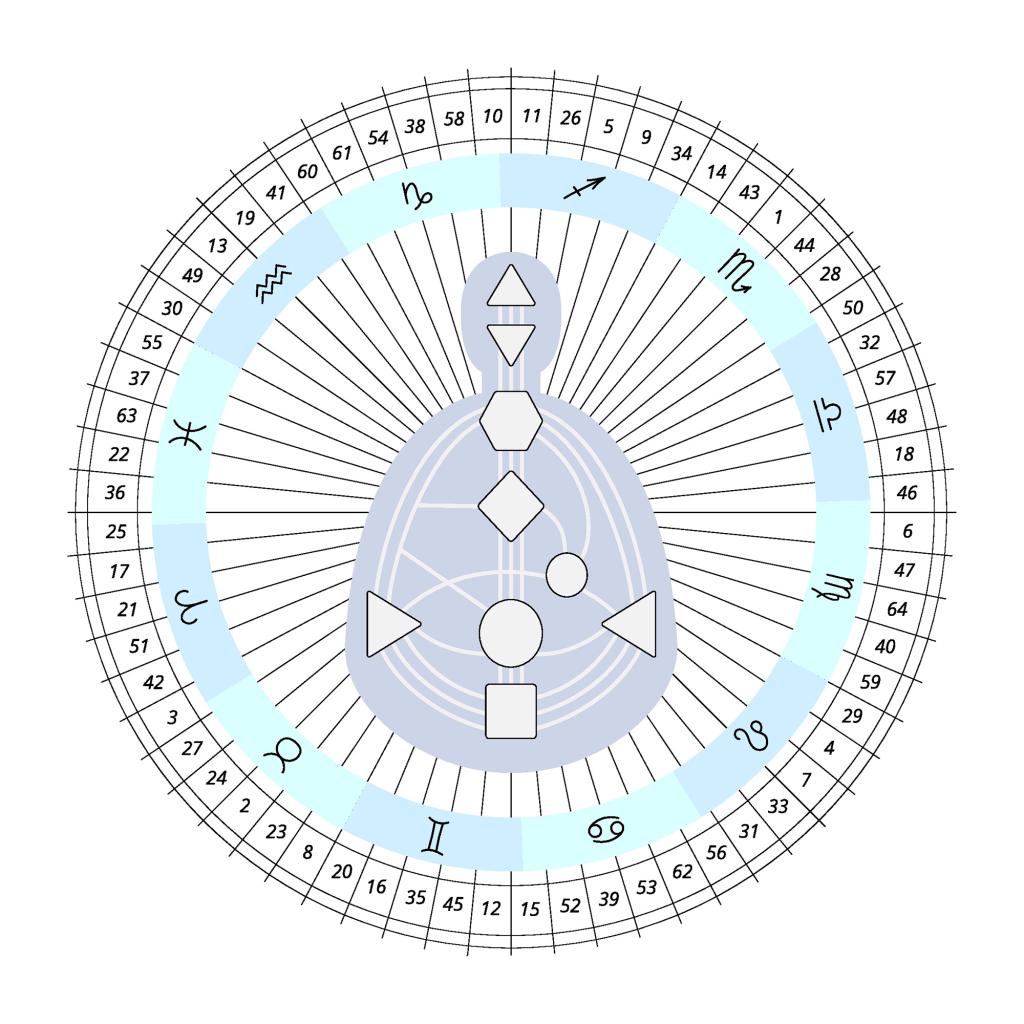Armenian mystic, Capricorn and first rate mustache ambassador G.I. Gurdjieff maintained, “Without self knowledge, without understanding the working and functions of his machine, man cannot be free.”
Human Design, a system of awareness that weaves together ancient divination and new age wisdom, promises that freedom through mastery of the machine of the self.
A relatively new practice, Human Design provides practical insights into how we distribute and can best harness our energies, respond to others, approach conflict and make authentic choices.
The crux of Human Design suggests that our failures, falterings, burnouts and backpedaling are a direct result of working against our essential energy and out of alignment with our coded natures. Can dig.
Whether you’re versed in, or resistant to, astrology, straining to hear your true calling or looking for another form of divination, Human Design might just be your ticket to ride. Read on to learn more and get right with your life path.
Guiding us through the fundamental of the practice is empathetic Pisces, babezilla, general conduit of greatness and Human Design expert Jasmine Kenna.
What is Human Design?
Developed by Aries Canadian Alan Krakower, later known as Ra Ura Hu, Human Design integrates astrology, I’Ching, Myers-Briggs, Kabbalism, Hindu-Brahmin chakra system, and quantum physics.
Here’s where s**t gets crazy folks.
Ra Ura Hu claimed that he “downloaded” the framework for Human Design from “the Voice,” a superior and otherworldly intelligence that spoke to him during an eight day mystical bender in Ibiza in 1987. Thus, a prophet of purpose was born. After his encounter Ra Uru Hu wrote the “Rave I’Ching,” a book described by disciples of the practice as, “the foundation upon which Human Design rests and the key to unlocking the code of our genetics,” according to the Jovian Archive.
Is Human Design better than astrology?
An individual’s Human Design is divined using a chart system. Similar to a birth chart in astrology, a Human Design chart or BodyGraph is determined by the exact time, date and place of birth. Unlike a birth chart, Human Design identifies dominant chakras, energy centers and gates. In this sense, Human Design incorporates and also supports the practice of astrology while differentiating itself as a more specific and arguably more dynamic system of belief. Kindred and complimentary you might say.
“Human Design is a science of differentiation, it’s about how your energy moves through the world,” Kenna explains. “I like to think of it as a blue print for how we experience ourselves and how we interact with others.”
This blue print is unique to the individual and reveals how our consciousness is configured and where our decision making is rooted. The Human Design chart ultimately serves as a guide to living, working, investing and expressing in a way that is aligned with our true natures and highest selves.
How to find your Human Design chart
There are several websites that offer free Human Design tests and calculators including MyHumanDesign and myBodyGraph. The resulting chart or diagram takes the form of the top half of a human body overlaid with chakra shapes, colors, lines, numbers and planetary symbols. The right side of the chart represents your conscious personality while the left indicates the unconscious. These charts also highlight your individual strategy type, how you express and exchange energy and your authority, how and from what place you make decisions. As Kenna explains, “Everyone thinks you should make decisions with your mind but in Human Design you always defer to your strategy and authority. It takes the guess work out of it.”
The chart and the information present within it can be complicated to approach. In addition to the aforementioned “Rave I’Ching,” “The Definitive Book of Human Design” offers foundational knowledge to beginners while The International Human Design School offers certification courses. For those looking to explore their own charts, booking a reading with an expert can be a wonderful way to wade into these waters. To book a reading with Jasmine Kenna, visit her website here.
Human Design types
In Human Design there are four different energy types and one hybrid, each with their own respective set of gifts and challenges, blessings and banes. Each energy type has a specific strategy, or affirmative system that encourages them to work in accordance with, rather than against, their respective life force.
Generator
Generators make up the bulk of the population. Energy is a renewable resource to this ilk and they are in alignment when they find work and pursuits that light them up and feed them well. People pleasing is a common problem with generators and they often feel like they can, and should, do and be all things to all people. The strategy of generators is to respond to outside forces, rather than initiate.
Kenna explains, “We live in a generator world, they’re the builders. Generators are not here to ‘just do it’ they need something to respond to and if they’re following what feels good, there’s plenty to respond to.”
Famous generators include Madonna, Albert Einstein, Oprah Winfrey and Elvis.
Manifestor
Disruptors and visionaries, manifestors are an impulsive lot who bear the mark of the divine and the divisive. Their energy is polarizing and can strongly attract or deeply repel in equal measure, they need to learn to trust that what is drawn to them is good for them and resist the urge to convince, cajole, or seek the approval of others. Autonomy is essential and solitude restorative for them. The strategy of manifestors is to inform and be transparent, through not necessarily flexible, about their plans and intentions.
Kenna explains, “Manifestors are not here to ask for permission, they are change makers. They tend towards sneakiness because they don’t want to be encroached upon and are also prone to rage black outs. The life of the manifestor is a lonely one because they know they are a force but they can’t always see themselves. They need a lot of love and minimal boundaries or expectations. They have to own their power and not resort to conforming or conceding, it is poisonous to their person.”
Famous manifestors include Frida Kahlo, Tom Cruise, Gloria Steinem and Maya Angelou.
Manifesting Generator
Combining the drive of a manifestor with the gumption of a generator, manifesting generators are here to experiment without commitment. Their energy is prodigious. curious and non linear. In order to feel fulfilled they must feel free to explore, fail, flourish and abandon. Discord develops when manifesting generators put all of their energy towards a single pursuit or person. The strategy for manifesting generators is to respond and then inform.
Kenna explains, “The difference between a generator and a manifesting generator is speed, manifesting generators move so quickly that it almost feels like they’re initiating but they’re still here to respond. They don’t like to be impeded, questioned or forced to finish.”
Famous manifesting generators include Bruce Lee, Ben Affleck, Miley Cyrus, Beyoncé and Ruth Bader Ginsburg.
Projector
Projectors are here to serve as guides; to share knowledge and support others through their powers of perception. A common challenge of projectors is self-defeat and unwelcome interjection, they must learn to be patient with their inconsistent energy and trust that when wanted and needed, their wisdom will be sought. The strategy for projectors is to wait for recognition and invitation.
Kenna explains, “Projectors have so much to offer but their auras are penetrating and penetration should always be consensual, that is why it’s crucial for them to wait to be asked before guiding and directing others”
Famous projectors include Princess Diana, Mick Jagger, Ariana Grande, Barack Obama and Queen Elizabeth II.
Reflector
The rarest strategy type, reflectors make up just 1 percent of the population, and operate as a mirror to others. Fluid in nature and sensitive to cycles of lunation, their energy similarly waxes and wanes. Because they are the star spangled unicorns of the world, they must find peace in, and through, their otherness. The strategy for reflectors is to wait for a lunar cycle to complete itself before they make decisions or otherwise embark.
Kenna explains, “If you think of the canary in the coal mine analogy, that’s what reflectors are. They are here to show the rest of us what the environment is doing and determine if that environment is healthy. They are here to be delighted, and when they are everything shines but when they are disappointed or disillusioned they can be absolutely nihilistic.”
Kenna maintains that types are equal and valuable contributors, “All of the types should work together and help one another and energize each other and it’ wonderful to have a reflector in the community to operate as a mirror and inform whether the whole is healthy.”
Maslow identified self-actualization as the pyramid tip of his Hierarchy of Needs. For Kenna, meeting that need began with an accidental stumble, “I discovered Human Design while listening to a podcast. The host was describing what I now know to be a manifesting generator and as she spoke I knew she was talking about me. I suddenly understood that I was not broken. I was a manifesting generator and I was here to move fast, I was here to try tons of things and It was okay for me to quit or pivot. I was okay. There was nothing wrong with me.
In that moment I felt the most me that I had ever felt. I started studying HD and reading charts so that I could show people that they are also not broken, that we all operate differently but we’re all okay.” I’ll be repeating that last nugget of conciliatory gold to myself ever after. If you’re into feeling free, understanding the glorious, individual workings of your own machine, and learning more about Human Design, follow Jasmine Kenna on Instagram and download the Spacious app.
Astrology 101: Your guide to the star
- The 12 zodiac signs
- What are the astrology houses
- Here’s what each planet represents
- Sun, moon, and rising signs: Get to know your Big 3
Astrologer Reda Wigle researches and irreverently reports back on planetary configurations and their effect on each zodiac sign. Her horoscopes integrate history, poetry, pop culture and personal experience. She is also an accomplished writer who has profiled a variety of artists and performers, as well as extensively chronicled her experiences while traveling. Among the many intriguing topics she has tackled are cemetery etiquette, her love for dive bars, Cuban Airbnbs, a “girls guide” to strip clubs and the “weirdest” foods available abroad.


























